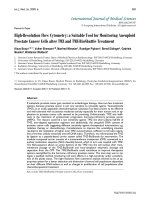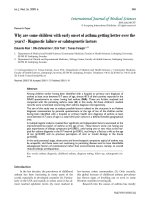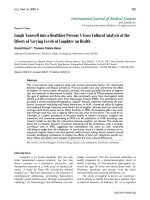Báo cáo y học: "High-Resolution Flow Cytometry: a Suitable Tool for Monitoring Aneuploid Prostate Cancer Cells after TMZ and TMZ-BioShuttle Treatment"
Bạn đang xem bản rút gọn của tài liệu. Xem và tải ngay bản đầy đủ của tài liệu tại đây (971.56 KB, 10 trang )
Int. J. Med. Sci. 2009, 6
338
I
I
n
n
t
t
e
e
r
r
n
n
a
a
t
t
i
i
o
o
n
n
a
a
l
l
J
J
o
o
u
u
r
r
n
n
a
a
l
l
o
o
f
f
M
M
e
e
d
d
i
i
c
c
a
a
l
l
S
S
c
c
i
i
e
e
n
n
c
c
e
e
s
s
2009; 6(6):338-347
© Ivyspring International Publisher. All rights reserved
Research Paper
High-Resolution Flow Cytometry: a Suitable Tool for Monitoring Aneuploid
Prostate Cancer Cells after TMZ and TMZ-BioShuttle Treatment
Klaus Braun
1
#
, Volker Ehemann
2
#
, Manfred Wiessler
1
, Ruediger Pipkorn
3
, Bernd Didinger
4
, Gabriele
Mueller
5
, Waldemar Waldeck
5
1. German Cancer Research Center, Dept. of Medical Physics in Radiooncology, INF 280, D-69120 Heidelberg, Germany
2. University of Heidelberg, Institute of Pathology, INF 220, D-69120 Heidelberg, Germany
3. German Cancer Research Center, Central Peptide Synthesis Unit, INF 580, D-69120 Heidelberg, Germany
4. Radiation Oncology, University of Heidelberg, INF 400, D-69120 Heidelberg, Germany
5. German Cancer Research Center, Division of Biophysics of Macromolecules, INF 580, D-69120 Heidelberg, Germany
#
The authors contributed by equal parts to this work
Correspondence to: Dr. Klaus Braun, Medical Physics in Radiology, Deutsches Krebsforschungszentrum (DKFZ), Im
Neuenheimer Feld 280, D-69120 Heidelberg, Germany. Tel: +49 6221 42 2495; Fax: +49 6221 42 3326.
Received: 2009.08.17; Accepted: 2009.11.16; Published: 2009.11.18
Abstract
If metastatic prostate cancer gets resistant to antiandrogen therapy, there are few treatment
options, because prostate cancer is not very sensitive to cytostatic agents. Temozolomide
(TMZ) as an orally applicable chemotherapeutic substance has been proven to be effective
and well tolerated with occasional moderate toxicity especially for brain tumors and an ap-
plication to prostate cancer cells seemed to be promising. Unfortunately, TMZ was ineffi-
cient in the treatment of symptomatic progressive hormone-refractory prostate cancer
(HRPC). The reasons could be a low sensitivity against TMZ the short plasma half-life of
TMZ, non-adapted application regimens and additionally, the aneuploid DNA content of
prostate cancer cells suggesting different sensitivity against therapeutical interventions e.g.
radiation therapy or chemotherapy. Considerations to improve this unsatisfying situation
resulted in the realization of higher local TMZ concentrations, sufficient to kill cells regard-
less of intrinsic cellular sensitivity and cell DNA-index. Therefore, we reformulated the TMZ
by ligation to a peptide-based carrier system called TMZ-BioShuttle for intervention. The
modular-composed carrier consists of a transmembrane transporter (CPP), connected to a
nuclear localization sequence (NLS) cleavably-bound, which in turn was coupled with TMZ.
The NLS-sequence allows an active delivery of the TMZ into the cell nucleus after trans-
membrane passage of the TMZ-BioShuttle and intra-cytoplasm enzymatic cleavage and
separation from the CPP. This TMZ-BioShuttle could contribute to improve therapeutic
options exemplified by the hormone refractory prostate cancer. The next step was to syl-
logize a qualified method monitoring cell toxic effects in a high sensitivity under considera-
tion of the ploidy status. The high-resolution flow cytometric analysis showed to be an ap-
propriate system for a better detection and distinction of several cell populations dependent
on their different DNA-indices as well as changes in proliferation of cell populations after
chemotherapeutical treatment.
Key words: TMZ-BioShuttle, Prostate Cancer Cells, Flow Cytometry
Int. J. Med. Sci. 2009, 6
339
Introduction
Prostate cancer (PCa) is the most common solid
tumor in men. In 2007, there will be approximately
220.000 men diagnosed with prostate cancer in the
U.S. [1]. The annual incidence of the male population
in West-Europe and the U.S.A averages approxi-
mately 88 per 100.000 men [2]. As the wide range of
the PCa’s aggressiveness shows: while some patients
are being able to live symptom-free and without any
treatment for many years, there are aggressive forms
with rapid growth and early metastatic spreading.
The current therapeutic options in the treatment of
PCa are: i) Radical excision of prostate and seminal
vesicles [3, 4]. ii) Percutaneous radiation therapy with
high energetic photons (6-23 MeV) [5, 6]. iii) Intersti-
tial radiation therapy with temporarily or permanent
radioactive implants (brachytherapy) [7]. iv) The
standard initial systemic therapy for locally advanced
or metastatic disease is hormonal or androgen depri-
vation therapy (ADT) that may be performed by bi-
lateral orchiectomy or pharmaceutical means. The
androgen-sensitive period in patients with metastatic
disease lasts a median of 14–30 months [8]. v) Che-
motherapy for hormone refractory prostate cancer
(HRPC) is possible using mitoxantrone plus predni-
sone [9] or with taxane-containing agents [10]. Despite
manifold combined therapeutic approaches for a
successful HRPC control in the past, metastatic AIPC
and HRPC is difficult to treat [11-18]. Unfortunately,
all current therapeutic options for patients with HRPC
turned out to be poorly effective and chemotherapy
had low response rates with median survivals of up to
only 12 months [14]. Therefore, chemotherapy has not
traditionally been offered to patients with HRPC as a
routine treatment due to its treatment-related toxicity
and poor response [19]. Despite initially encouraging
results of tumor growth control were reported in
other tumor types than brain tumors [20], the results
of a phase II study of TMZ in PCa have been dis-
couraging [21]. One of the reasons for this could be
the presence of aneuploid cell fractions, which offers a
broad spectrum of cells from highly sensitive up to
therapy resistant [22]. In addition, the therapy resis-
tant cell fraction gains a selective advantage after
therapeutic intervention. The DU 145 cell line, pre-
senting a cellular heterogeneity, suggests behaviour’s
similarity to advanced HRPC tumors. As demon-
strated by karyotypic analyses DU 145 show an ane-
uploid human karyotype with a modal chromosome
number of 64. Marker chromosomes like translocated
Y chromosome, metacentric minute chromosomes
and three large acrocentic chromosomes have been
identified [23, 24] which in their entirety can be re-
sponsible for the constricted sensitivity against alky-
lating agents.
It is clear that effort is necessary to search for
new forms of treatment modalities like drug delivery
and targeting systems realizing high local TMZ con-
centrations in the nuclei of target cells. To eradicate
the target cells, without considering the HRPC cells
resistance against therapeutic interventions it is nec-
essary to find convenient methods which allow the
monitoring of the therapy progress and success at the
cellular level. Flow cytometric analysis should be able
to detect several cell populations dependent on their
different DNA-indices, which are corresponding to
different amount in chromosome numbers. By this
method, the genetic integrity and stability can be
analyzed [25].
Materials & methods
Cell culture
The hormone refractory adherent prostate cancer
cell line DU 145 [24] was cultivated and maintained in
RPMI cell medium (Gibco, Germany) supplemented
with 5% fetal calf serum and 4 mM glutamine (Bio-
chrome, Germany) at 37°C in 5% CO
2
atmosphere.
Chemical procedures
The syntheses of the investigated peptide-based
functional modules like the cell penetrating peptide
(CPP) and the nuclear localization sequence (NLS) as
well as the syntheses of tetrac
y-
clo-[5.4.2
1,7
.O
2,6
.O
8,11
]3,5-dioxo-4-aza-9,12-tridecadien
acting dienophile and the tetrazoline-derivatization of
the active compound temozolomide to
(TMZ-tetrazine diene) (Table 2, left column), and in
the end, the both ligation procedures, firstly the liga-
tion of the dienophile-NLS module (Table 1, upper
row) with cell penetrating peptide (CPP) (Table 1,
lower row) by a reversible disulfide-bridge formation,
and secondly, the compounds for the ligation in virtue
to the Diels-Alder-Reaction with inverse elec-
tron-demand extensive described by Braun [26] and
Pipkorn [27] are illustrated in Table 2.
All reactions and procedures were carried out
under normal atmosphere conditions. The Figure 1
exhibits the constitutional formula of investigated
active TMZ-NLS component.
Int. J. Med. Sci. 2009, 6
340
Table 1 Schematic ligation pattern of the K(TcT)-NLS-Cys & CPP-Cys modules by disulfide bridge formation. Itemized
modules of the investigated TMZ-BioShuttle. The upper line shows the chemical structure of the tetrac
y-
clo-[5.4.2
1,7
.O
2,6
.O
8,11
]3,5-dioxo-4-aza-9,12-tridecadien (TcT) acting as dienophile compound in the DAR
inv
. It is connected
via the ε-amino-coupling of the lysine spacer to the nuclear address sequence (NLS). At the right site of the table the CPP
module in the single letter code mode is represented. In the upper line the corresponding module in the single code mode
is represented.
Table 2 Middle and right part of the table represents the dienophile-educt for the DAR
inv
: K(TcT)-NLS-S
∩
S-CPP and the
TMZ tetrazine spacer derivatized acts as a diene compound as a cargo (left column).
Int. J. Med. Sci. 2009, 6
341
Figure 1 Constitutional formula of the investigated TMZ-BioShuttle
Cell Cycle and Cell Death Analysis
The effects on the cell viability and the cell cycle
distribution were determined by DNA flow cytome-
try.
Flow cytometric analyses were performed using
a PAS II flow cytometer (Partec, Munster/Germany)
equipped with mercury lamp 100 W and filter com-
bination for 2, 4-diamidino-2-phenylindole (DAPI)
stained single cells. From native sampled probes the
cells were isolated with 2.1% citric acid/ 0.5% Tween
20 according to the method for high resolution DNA
and cell cycle analyses [28] at room temperature with
slightly shaking. Phosphate buffer (7.2g Na
2
HPO
4
×
2H
2
O in 100ml H
2
O dist.) pH 8.0 containing 2,
4-diamidino-2-phenylindole (DAPI) for staining the
cell suspension was performed. Each histogram
represents 30.000 cells for measuring DNA-index and
cell cycle. For histogram analysis we used the Multi-
cycle program (Phoenix Flow Systems, San Diego,
CA).
Human lymphocyte nuclei from healthy donors
were used as internal standard for determination the
diploid cell population. The mean coefficient of varia-
tion (CV) of the diploid lymphocytes was 0.8 - 1.0.
Cell viability and apoptotic cells were assessed
by flow cytometry with propidium iodide
(PI)-method. For detection of apoptotic cells and vi-
ability a FACS Calibur flow cytometer (Becton Dick-
inson Cytometry Systems, San Jose, CA) was used
with filter combinations for propidium iodide. For
analyses and calculations the Cellquest program
(Becton Dickinson Cytometry Systems, San Jose, CA)
was used. Each histogram represents 10.000 cells. Af-
ter preparation according to Nicoletti with modifica-
tions [29, 30] measurements were acquired in Fl-2 in
logarithmic mode and calculated by setting gates over
the first three decades to detect apoptotic cells. The
effect of the used solvent acetonitrile on the viability
of lymphocytes was without pathological findings.
Preparation of short term lymphocytes
Human lymphocytes were isolated from 30ml
native venous blood from a healthy donor by a lym-
phocyte preparation with Lymphoprep
TM
gradient
(AXIS-Shield PoC AS, Norway) under sterile condi-
tions. A short term culture was established with lym-
phocytes using RPMI 1640 medium, containing 10%
foetal calf serum and Phytohemagglutinin (PHA-P)
(5mg/ml) in phosphate buffer solution PBS (Sigma,
Germany) at 37°C and 5% CO
2
for 144 hours.
Treatment of lymphocytes was followed by
identical procedures according to the DU 145 cells.
The suspension culture was harvested by centrifuga-
tion at 800rpm for 10min, rinsed in PBS and marked
with propidium iodide (PI) before measurement in a
FACS-calibur flow cytometer (Becton & Dickinson,
Germany) equipped with a 488nm argon laser and
emission filter combinations for red fluorescence
(610nm) using the Cell Quest acquisition and analyses
software (Becton & Dickinson, Germany). For analysis
a minimum of 10.000 cells were counted and the re-
sults were presented as histograms in logarith-
mic-modus. The specific fluorescence intensity was
calculated as the ratio of the geometric mean fluores-
cence values obtained with the specific PI-uptake.
Results
The aims of the study were:
1. to achieve a rapid and high local concentration
and an accumulation of TMZ derivative within the
cell nuclei using the TMZ-BioShuttle as delivery and
targeting system.
Int. J. Med. Sci. 2009, 6
342
2. the presentation, distinction and evaluation of
the cell cycle behaviour of aneuploid DU 145 prostate
cancer cells after treatment with TMZ alone and with
its TMZ-BioShuttle derivative.
Control DU 145 cells form a continuous
monolayer, while treated DU 145 cells show loss of
adhesion primarily in the TMZ-BioShuttle treated
cells combined with spread and attached to the
well-plate. Whereas in the TMZ treated cells, the cell
closeness was declined and accompanied with an in-
crease of amount of dead cells in the supernatant.
Using the flow cytometry technique not only a
differentiation in the cell cycle state of DU 145 cells
but also a schedule line of the diploid (red) and an
aneuploid (blue) DNA content of the DU 145 cells is
demonstrated as shown in Figure 2 and table 3 A,
graphically visualized in 3B.
Figure 2 The figure shows the cell cycle distribution of DU 145 cells: In the left part of the figure the plot of the untreated
control is demonstrated, the middle and the right plot show the cell cycle distribution 144 h after treatment with
TMZ-BioShuttle and TMZ respectively. The prostate cancer cell line exhibits two cell fractions: a diploid (DNA-index of
1.0)[red coloured] and an aneuploid fraction (DNA-index 1.1)[blue coloured], close to the diploid. The G1 and the G2M
peaks show a diploid and an aneuploid DNA content respectively. S-phase: After TMZ treatment (right plot) the cell number
of the aneuploid cells is 10% higher (59 %) compared to aneuploid S-Phase cells in the TMZ-BioShuttle treated probe (middle
plot). This in turn was 1.8 fold increased (49 %) compared to the corresponding cell fraction of the control (27 %). The
relative amount of the diploid cell fraction differs from the aneuploid fraction: The control shows 35 % diploid cells. The
aneuploid fractions reveal decreased amounts 15% (TMZ-BioShuttle) and 3% (TMZ). G2/M phase: The cell cycle behaviour
of both cell fractions, the diploid and the aneuploid, show partly opposing effects. In comparison to the control which shows
identical percentage of the diploid and the aneuploid cells, the TMZ and the TMZ-BioShuttle treated probes display an
increased diploid cell fraction in which the TMZ-BioShuttle probe shows the highest cell contingent. The fraction of ane-
uploid cells is reduced to 11% whereas the diploid part is increased to 28% in the TMZ-BioShuttle treated probe. The
amount of cells in the G2/M phase is increased in a similar ratio of 25 % diploid and 24 % aneuploid cells in the TMZ probe.
G1-phase: The comparison of the amount of aneuploid and diploid cells in the G1 phase shows a ratio of 49 % and 54%. The
cells in the G1 phase of the TMZ treated probe was increased to 73 % (diploid) and 57 % in the TMZ-BioShuttle probe. The
aneuploid cell fractions exhibit an opposite result: the aneuploid cell fraction is decreased to 41% (TMZ-BioShuttle) and 17
% (TMZ).









